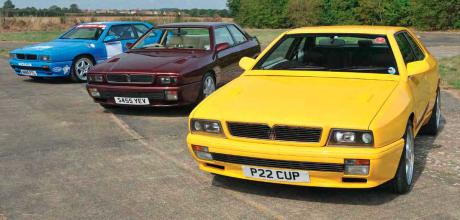1992 Maserati Ghibli 2.8 GT Auto Tipo AM336 vs. Ghibli Open Cup Tipo AM336 and Ghibli II Cup Tipo AM336
The final iteration of the Biturbo family – the Ghibli II Tipo AM336 – was launched 30 years ago. While it blew through the 1990s with plenty of praise, it breezed over most people’s heads. Today, we investigate how it’s going down a storm with a new generation of enthusiasts.
Story by Nathan Chadwick
Images by Michael Ward
Second Wind
GHIBLI FEVER! MASERATI TRIPLE TEST
30th birthday triple test of an underrated classic
Albert Einstein once said, “In the middle of difficulty, lies opportunity”. This phrase could easily be applied to Maserati at the dawn of the 1990s – it had made a V8 GT car to take on the USA (the Shamal) but found itself priced out by prohibitive import legislation. Then the Asian economy collapsed and the demand for expensive cars dwindled to the point when even Ferrari had to discount its Testarossa by up to 30 per cent to empty the factory stable.
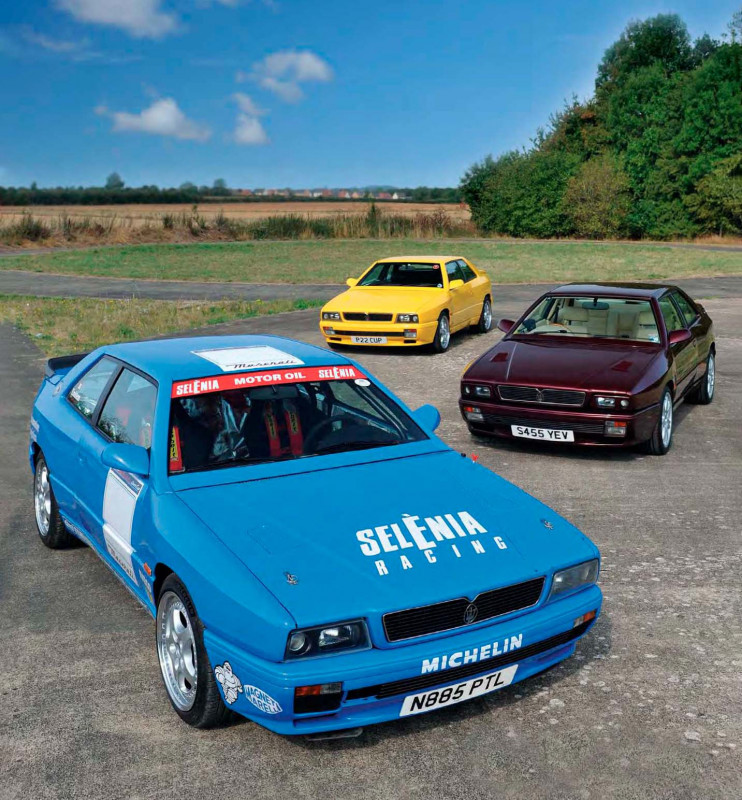
In the midst of this, the Ghibli II Tipo AM336, launched in 1992, was a spark of good news. Although its development budget wasn’t huge – it was basically an evolution of the long-established Biturbo – designer Marcello Gandini cleaned up and smoothed the body for a more athletic look. The engines were potent developments of Maserati’s 222 4v and Italian-market Racing, and quality standards were notably improved, even if ergonomics would remain a familiar bugbear for anyone not of Italian proportions.
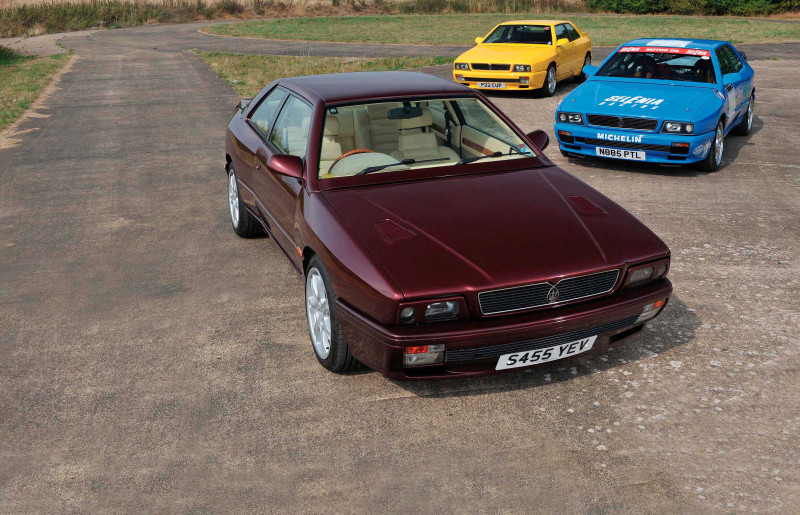
Thirty years on from the car’s launch, and 28 since it first came to the UK, the Ghibli II is seeing a renaissance of interest, fed by a love of square-edged designs like the Lancia Delta and Alfa Romeo SZ. To celebrate its anniversary, we’ve brought together a UK market 2.8 GT, a Cup and an Open Cup racing car, fresh from restoration. It’s time to wind up the boost.
1992 MASERATI GHIBLI 2.8 GT AUTO TIPO AM336
The Ghibli II Tipo AM336 was launched at the Turin Motor Show in April 1992 in 2.0-litre guise, with a distributor and fuel injection system similar to that of the outgoing 2.24 and 222 4v, but this only lasted a year before being upgraded to a new system. Just like the Biturbos that came before the Ghibli II, the UK-market car was significantly different. Instead of the 2.0-litre V6 engine, most export markets – including the UK – got a 2.8-litre engine that traded top-end punch for meatier mid-range thump. In contrast to the 2.0-litre unit’s aluminium cylinder liners, the 2.8-litre engine had iron. Early cars did without anti-lock brakes and transmitted power to the road via a five-speed Getrag manual gearbox or four-speed ZF automatic ZF4HP22, plus a Ranger rear limited-slip differential.
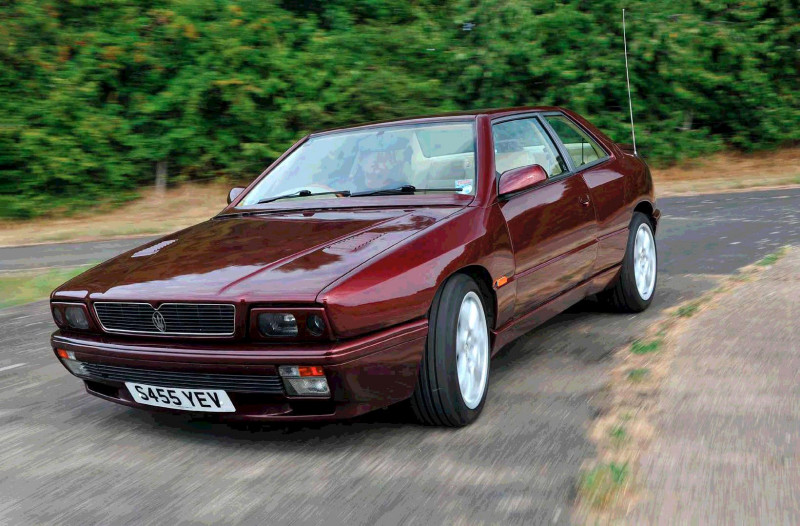
The next stage came in 1994, which didn’t turn up in the UK until a year later – the key change being new Bosch ABS. For 1995, came a new Kit Sportivo option, consisting of thicker anti-roll bars, lower suspension and 17in OZ Futura alloy wheels. A 1996 upgrade and new GT badging included a six-speed manual gearbox, 17in alloy wheels, Ferrari 456-derived rear axle and diff, and tubular lower wishbones instead of pressed steel rear suspension.

It’s a GT that we have to play with today, courtesy of Ghibli II enthusiast, Ian Roberts. He owns two Ghibli IIs – his other is a similarly-hued left-hand drive 2.0- litre car. If you’ve never sat in a Maserati of this era, it’s quite the sensory experience. Nothing smells quite like it, even if the Connolly leather is shared with British luxury marques. The leather feels soft, warm, inviting, boosted by lovely wood inserts and visible stitching. Compared to the funereal cockpits of most luxury cars on sale today, the Maserati feels very special, and higher quality than earlier Biturbos. Well, mostly. The indicator stalks feel as if they’re about to come off in your hand and the selector for the Koni four-stage dampers looks like a reject from an old Maplin catalogue.

It’s all about the driving, however, and the Ghibli II doesn’t disappoint. It’s not the most sonorous of engines – you can thank the twin turbos for that – but there’s a nice deep burble that turns into a growl once you start to extend the V6. What’s surprising is just how connected the steering feels – this may be the slightly softer, GT version of the car, but there’s a connectedness to the front wheels that comes through the steering wheel that’s revelatory compared to more recent Maseratis, which can feel remote at times. This is very much a car set up for fast cruising, but there’s plenty of confidence-boosting information summoned up through the steering wheel.
The 17-inch wheels have plenty of sidewall, which means the ride is smooth even with the adaptive damping in its harder settings. The only fly in the ointment is the automatic gearbox, which, like every slushbox of this era, feels very old-school compared to modern self-shifters. But compared to its contemporaries, say a Porsche 911 993 Tiptronic, the Ghibli’s superior torque makes operation much smoother and enjoyable. However, it’s easy to see how sudden kickdown and 414Nm of torque might make busy T-junctions somewhat perilous. The manual is the one to have for keen drivers, but these are vanishingly rare – harder to come by than even a Cup. The 2.8 GT is a surprise package: it might not be quite as sporty as its Cup brethren, but its dynamic abilities will surprise you – even with an automatic gearbox.
TECHNICAL SPECIFICATIONS 1992 Maserati Ghibli 2.8 GT Auto Tipo AM336
- ENGINE: 2790cc V6 twin-turbo DOHC 24v
- COMPRESSION RATIO: 7.4:1
- MAX POWER: 284hp at 6000rpm
- MAX TORQUE: 414Nm at 3500rpm
- TRANSMISSION: 4-speed automatic, RWD
- WEIGHT: 1365kg
- MAX SPEED: 161mph
- 0-62MPH: 5.7se
2.8 auto cruiser may not be the enthusiasts’s choice but the GT feels surprisingly keen to drive.
“This may be the softer GT but the connectedness to the front wheels through the steering wheel is revelatory”
1996 MASERATI GHIBLI OPEN CUP TIPO AM336
The Ghibli II really did have its work cut out for it – not only was it developed with the sort of budget that Mercedes-Benz devotes to wing mirrors, but it was also launched into a global recession. Worse still, Maserati was teetering on the brink of collapse. Owner Alejandro De Tomaso concocted the Ghibli II-engined Barchetta, but this would only last two years and was soon culled after De Tomaso sold Maserati to Fiat. However, it sowed the seeds of a one-make series in the minds of those close to Maserati at the time.

Sales of the new Ghibli II were disappointing and something needed to be done. The answer came via Adolfo Orsi, a member of the family that once owned Maserati. He proposed a one-make series, with his company Historica Selecta handling the organisation, logistics and marketing, while Maserati – via Alfa Corse – handled car preparation.

Based on the 2.0-litre version of the Ghibli II, power was upped from 306hp to 320hp thanks to new roller bearing turbos, freer-flowing exhausts shorn of their catalysts and upgrades to the fuel and ignition mapping. The suspension was beefed up, too, particularly at the rear – tubular rear trailing arms were used rather than the pressed steel items then on the road cars. There was extensive safety kit, including a rollcage and Sparco race seats, but the road car’s dashboard and clock remained.

Would-be racers had to part with £48,000 for the car and a further £9000 to race in 1995’s eight-round series, which largely followed the DTM/ITC Touring Car series across Europe. The likes of Paul Radisich, Tiff Needell and Miki Biasion got behind the wheel. In the end, rookie Denny Zardo took the championship. Improvements for 1996 included a more extreme bodykit and much-needed improvements to the front brakes, plus an extra 10hp. The new Evo looked great, but after just two races the plug was pulled. Infighting between the bosses of Fiat and Maserati were reaching a head, leading to Ferrari being placed in charge of the Modena brand in 1997. Ferrari was a bit miffed at Maserati’s one-make operation, especially as the Ghibli Open Cup was capable of lapping faster than a 348 Challenge, and the series was culled. Maserati bought back the cars at huge cost and set about converting them for road use. The precise number of cars produced is unknown – perhaps as many as 36.
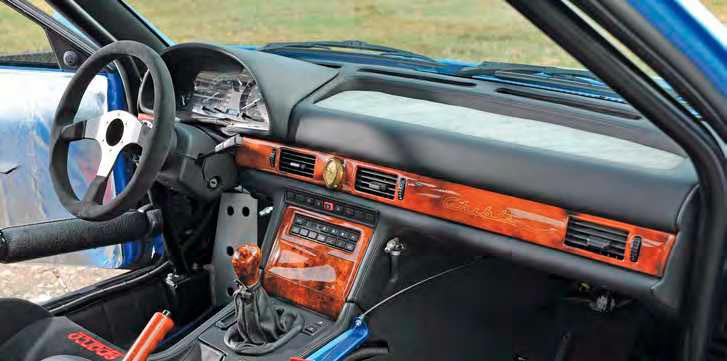
The car before you is a 1996 Evo factory test car that belongs to Doug Blair. When he found it, it was in road-going specification and was fitted with a Shamal interior. Over the past few years, Emblem Sports Cars of Poole has painstakingly returned the car to race specification, although it’s still road legal. It’s been prepared to 1995 rules – the Evo bodykit would barely get over painted lines, let alone potholes – and it made its post-restoration debut at Auto Italia’s Brooklands Italian Car Day earlier this year.
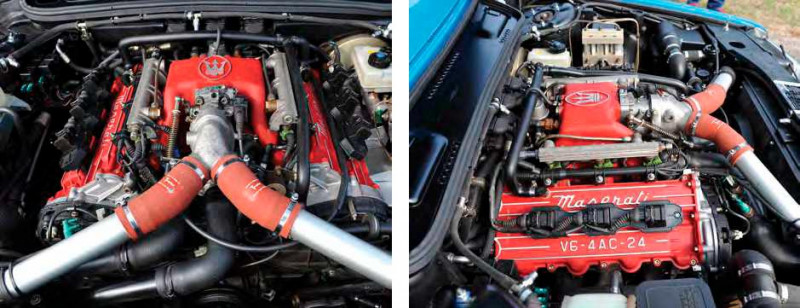
320hp 2.0 engine feels very torquey and very loud. Suspension is surprisingly compliant for a track car
Our test track was a little too small to explore the outer limits of the Open Cup’s potential, so our driving experience was limited to a brief excursion on public roads. It’s as loud and visceral as you’d expect from a racing car with number plates, but what’s surprising is just how compliant the suspension feels on pockmarked public roads. The engine, too, feels different, hitting peak torque quicker than you might imagine, with the power coming in lower down, too. One to investigate on a track in the summer, methinks.
TECHNICAL SPECIFICATIONS 1996 Maserati Ghibli Open Cup Tipo AM336
- ENGINE: 1996cc V6 twin-turbo DOHC 24v
- COMPRESSION RATIO: 7.6:1
- MAX POWER: 320-330hp at 6500rpm
- MAX TORQUE: 371Nm at 4250rpm
- TRANSMISSION: 6-speed manual, RWD
- WEIGHT: 1270kg
- MAX SPEED: 167mph
- 0-62MPH: 4.1sec

1997 MASERATI GHIBLI CUP TIPO AM336
Even though the racing series had ended sooner than planned, Maserati still saw the benefit of producing a roadgoing version of its racing car – the Cup. According to Maserati, the engine produced 330hp, more than the racing car in the first year. However, one owner who picked up his Ghibli Cup from the factory was told that it was actually far more than that – perhaps 340hp to 360hp. Apparently Maserati didn’t want to affect sales of its far more expensive – and less powerful – Shamal.

The base was the 2.0-litre V6, but with similar upgrades to the GT and Open Cup. A set of 17in Speedline alloy wheels housed stiffer Eibach springs and upgraded Brembo brakes. The specification came together to create something extraordinary, the likes of which we haven’t seen from Maserati since. A cursory look at the spec sheet might not be that impressive compared to today’s modern hyper-hatches, but at the time, it had the highest output per litre of any road car (165hp per litre), which would take more than a decade to be topped. It also had rear-wheel drive, no traction control, weighed very little and sat on relatively skinny 245/40 rear tyres.
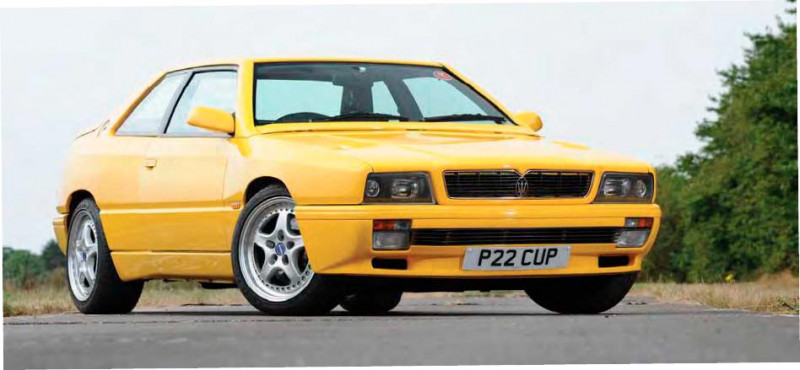
Maserati refused to import the 2.0-litre Cup to the UK. Various reasons have been mooted for this: it would have cost too much to homologate, and the UK importer believed nobody would pay nigh-on £46,000 for a 2.0-litre car. But the persistence of a couple of Maserati aficionados – Harry Metcalfe (of Evo magazine fame) and Drummond Bone – opened the doors for 26 UK cars to be built.
It is the ex-Drummond Bone car that you see before you, now owned by McGrath Maserati’s Andy Heywood. The eagle-eyed among you will notice the lack of Ghibli Cup badging – Drummond specified this for a more discreet look… on a bright yellow car!

Step inside and the changes are subtle – a lovely thick Momo steering wheel and carbonfibre trim to replace the wood – but it doesn’t take long to appreciate the vast differences over the GT. The Cup chunters along on idle, much like an air-cooled Porsche 911 might. However, as 2500rpm whisps into view and the ‘natural’ torque of the V6 starts to wake up, the power smoothly comes in and then, at around 4000rpm, the IHI roller-bearing turbos burst on to the scene with eyepopping force.
So is this an unruly brute, a TVR with Armani trimming and forced-induction steroids? In the wet, you certainly have to be awake – it has a relatively short wheelbase, after all. Provoke things with your right foot and it’ll wiggle its rear end. However, drive it with delicacy and it’s almost as compliant point-to-point as a Delta integrale, despite having fewer driven wheels.
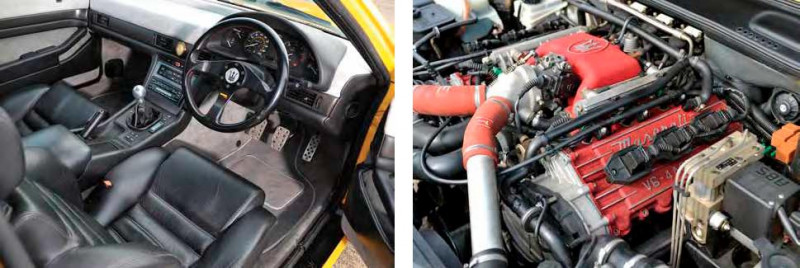
It has everything to do with what’s coming through the Momo steering wheel. It’s easy to forget now, but a sports car with power steering was a relatively new concept in 1995. The idea didn’t always come off – Ferrari’s F355 wasn’t perfect, for example – but the Ghibli Cup feels as if your frontal lobe has a USB connection to the wheels. Yes, there’s more bounce through the steering than the GT over rough roads, but that helps you read the bitumen more clearly. Add in the peaky engine, which revs to 7000rpm, and suddenly this is no longer a GT car, it’s pure motorised adrenaline.
There are downsides – the driving position isn’t great, there’s no room for your clutch foot on RHD cars and you really do have to rev the engine to get the best out of it. But all this fades away once you get past 4000rpm. It’s not just me eulogising – in 1997, Autocar magazine plastered a Ghibli II on the cover, saying it left the BMW M3 E36 gasping. Have that, Munich.
TECHNICAL SPECIFICATIONS 1997 Maserati Ghibli II Cup Tipo AM336
- ENGINE: 1996cc V6 twin-turbo DOHC 24v
- COMPRESSION RATIO: 7.6:1
- MAX POWER: 330hp at 6750rpm
- MAX TORQUE: 371Nm at 4500rpm
- TRANSMISSION: 6-speed manual, RWD
- WEIGHT: 1365kg
- MAX SPEED: 168mph
- 0-62MPH: 5.6sec
“Provoke things and it’ll wiggle its rear end. However, drive with delicacy and it’s almost as compliant point-to-point as a Delta integrale”
VERDICT
The Ghibli II GT Tipo AM336 auto cost £48,662 in 1996 – that’s just over £87,000 in today’s money – and as such, you have to treat is an exotic car, with suitably exotic running costs. The good news is that classic values have yet to reach exotic levels. You might be tempted by the Ghibli’s successor, the similarly priced Maserati 3200 Tipo 338, with its more classically beautiful styling and an extra two cylinders, but it’s even more difficult to look after, and drives in an entirely different way. Even the sharpest 3200 – the Assetto Corsa – has steering that feels far more remote than the Ghibli II 2.8, which is overall more nimble, biddable and engaging.
In Cup form, the Ghibli II not only takes the battle to the Porsche 911 but surpasses it. What the Cup lacks in terms of the GT’s ease of use, it pays back with an up-and-at-’em driving technique. It remains one of the most invigorating driving experiences you can have. It’s just a pity that so few Cups were built, with just a handful remaining in running condition. Even in automatic form, the Ghibli whips up a storm of emotions – just like a proper Maserati should.
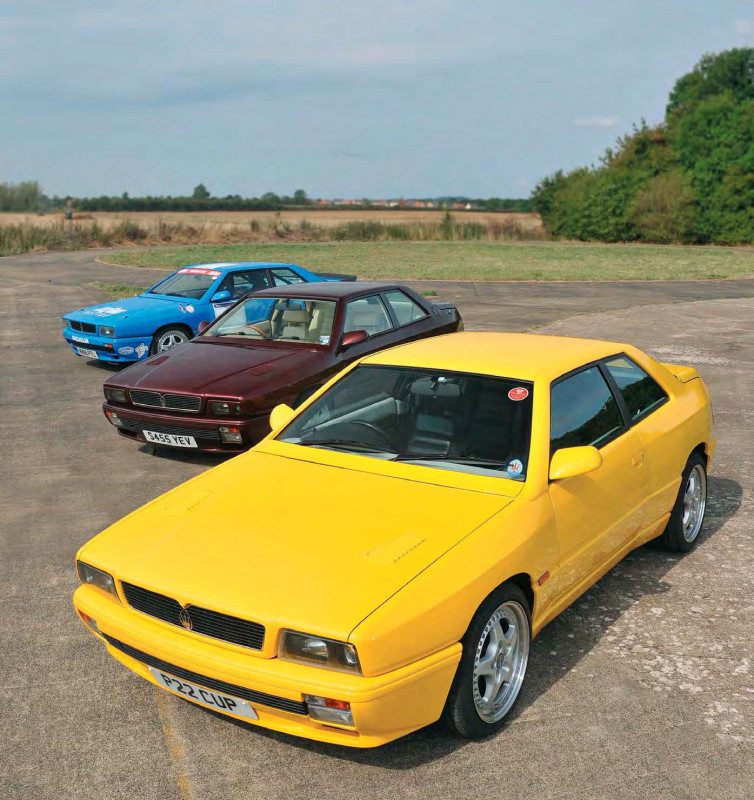
PRIMATIST
In 1996, Bruno Abbate and Guido Capellini built the Primatist, a speedboat powered by a tuned 370hp Maserati Ghibli Cup engine – and duly set a world record for the flying kilometre. Maserati celebrated this feat with a special edition Ghibli road car called the Primatist in 1997 (above). It used a standard Italian-market 306hp 2.0-litre engine, but with special Ultramarine Blue exterior paint, two-tone blue-and-turquoise leather, and a burr walnut dashboard, side panels, gearknob and steering wheel. Just 34 examples were made.


